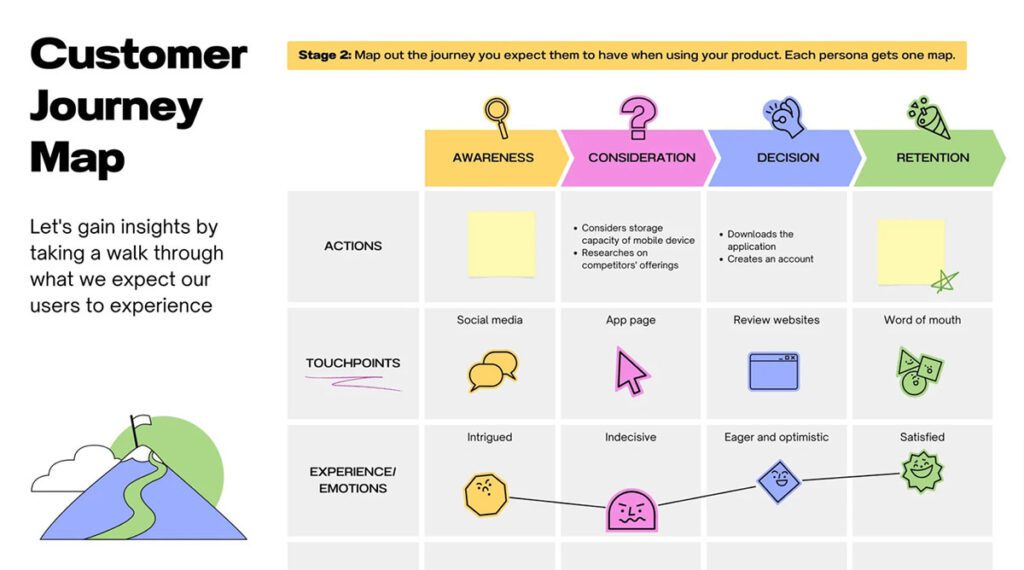Previous:
Next:
Mapping the customer journey
Imagine Sarah, a 34-year-old small business owner juggling with an endless to-do list. She’s searching for a solution to simplify her bookkeeping, and wants something intuitive, reliable, and not outrageously priced.
Now, let’s say your business offers the perfect solution. But here’s the problem, Sarah doesn’t know you exist. Even if she stumbles upon your website, she’s overwhelmed by jargon, endless features, and no clear path to the solution she’s after. Confused, she clicks away and ends up choosing a competitor.
Not because they’re better, but because they spoke to her needs at each step of her journey
Now let’s rewind. This time, your business has mapped out Sarah’s customer journey. You’ve anticipated her struggles, her questions, and her decision-making process.
When she Googles “easy bookkeeping software for small businesses,” your tailored blog appears. It answers her immediate questions in a clear, helpful way, with a subtle invitation to explore more.
As she moves through your site, your content flows seamlessly, guiding her from curiosity to trust, and eventually to purchase. Sarah doesn’t just buy your solution, she feels confident in her choice, even recommending you to other business owners.
That’s the power of customer journey mapping. It’s not about selling at every touchpoint, it’s about understanding the customer’s experience and creating a path that feels natural, helpful, and, ultimately, compelling.
Did you know
Based on a study executed in late 2021, 36 percent of responding business-to-business companies worldwide made use of both personas and customer journey maps as strategies to help them understand their customers – Statista

A customer journey map is a visual representation of how your customers interact with your brand at every stage, from first discovering you to becoming loyal advocates. It tells the story of their experience, step by step, touchpoint by touchpoint. But a journey map is far more than a pretty diagram. Done well, it’s a strategic tool that allows you to step into your customers’ shoes, identify gaps, and improve their experience at every turn. It’s about answering a critical question: What is my customer thinking, feeling, and doing at this stage?
When you understand the journey, you stop guessing and you start delivering.
Stages of the customer journey
Every customer journey can be broken into five main stages. Let’s revisit Sarah to explore how these play out.
Awareness
First, your customer enters the awareness stage of the customer journey. This is the moment they realise they have a problem or need. For Sarah, it’s that nagging feeling of being buried under bookkeeping tasks, unsure how to simplify her workload. Your role is to be visible and helpful. Sarah isn’t ready to buy just yet, she’s exploring options. A blog titled “5 Common Bookkeeping Struggles (and How to Solve Them)” or a free webinar about saving time on accounting could be the perfect starting point.
Consideration
In the consideration stage, Sarah is actively researching potential solutions. She’s comparing features, prices, and reviews to decide which option fits her needs. Your role is to stand out with trust and clarity. Offer downloadable comparison guides, showcase testimonials, and highlight benefits in a way that resonates. Remember that Sarah isn’t interested in what you offer, she wants to know why it’s right for her.
Decision
At the decision stage, Sarah is narrowing down her choices and preparing to take the plunge. She’s reading your FAQs, checking pricing pages, and maybe even debating whether to click “Buy Now.”
Your role is to remove friction. Provide crystal-clear CTAs, offer live chat for last-minute questions, and make sure your purchase process is simple. For Sarah, a limited-time discount or a demo could tip the scale.
Retention
The next stage is about retention. Sarah has purchased your software. Success? Not quite. Now, your focus shifts to making her experience so seamless and valuable that she stays.
Your role is to deliver value consistently. Offer onboarding emails, video tutorials, and excellent customer support. For Sarah, a helpful prompt like, “5 Tips to Maximise Your New Bookkeeping Software” could cement her trust.
Advocacy
Finally, if Sarah loves your product and experience, she becomes an advocate. She tells her network, leaves glowing reviews, and might even share her story. Your role is about celebrating her loyalty. Invite her to a referral programme, share her success story, or simply thank her for choosing you.
So, you’re ready to create a customer journey map, but where do you start?
Define your personas
First, before you map a journey, you need to know who is taking it. Use customer personas to identify key audience groups, such as Sarah. Remember to include their demographics, pain points, goals, and preferences.
Identify touchpoints
Next, list every interaction customers have with your brand, whether it’s online (social media, emails, website) or offline (events, customer service calls). Plot these touchpoints along the journey stages.
Ask yourself: What is my customer thinking, feeling, and doing at this stage? Is Sarah feeling frustrated? Confused? Excited?
These insights into motivations and emotions allow you to address her needs effectively.
At each stage, identify barriers that could stop customers from moving forward. For Sarah, is your pricing unclear? Is your website too complicated? Being able to pinpoint pain points and fixing these issues can drastically improve conversions.
Create a visual representation
Tools like Lucidchart or Canva can help you design a map that’s easy to understand and actionable. Take action by using your map to make meaningful changes. Whether it’s optimising your website, simplifying your checkout process, or tailoring your email campaigns, align your strategy with what your map reveals.
Why customer journey maps matter
Without a journey map, you risk leaving customers like Sarah lost, frustrated, or underwhelmed. But with one, you turn fragmented interactions into seamless experiences. You replace confusion with clarity, frustration with trust, and hesitation with confidence. When businesses truly understand their customers’ journeys, everything changes. Marketing becomes relevant. Sales become effortless. Loyalty becomes organic.
Customer journey mapping isn’t just a strategy, it’s a mindset. It’s about viewing every decision through the lens of your customer, ensuring they feel understood and valued every step of the way. So, the next time Sarah—or anyone like her—sets out on their journey, will your brand be the trusted guide they choose?
Start mapping, and make every journey count.


















Leave a comment